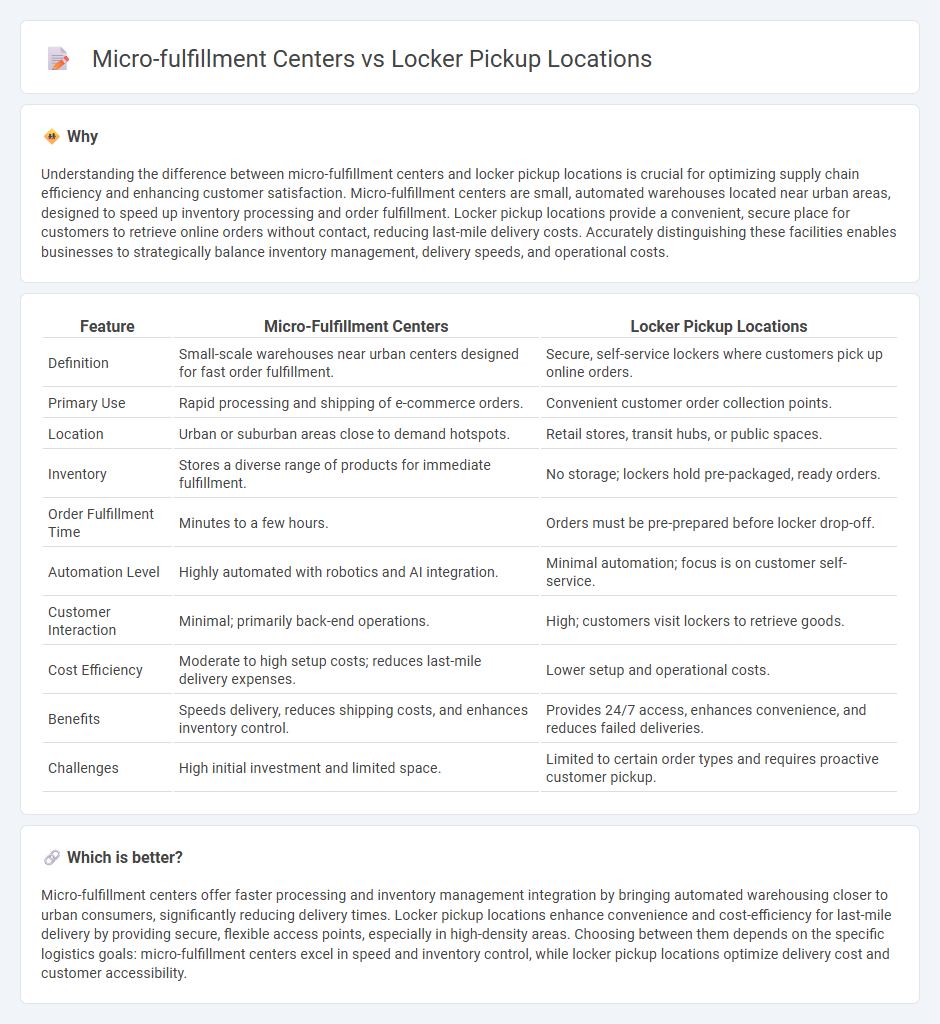
Micro-fulfillment centers leverage automation and proximity to urban areas to expedite order processing and same-day delivery, optimizing last-mile logistics. Locker pickup locations provide secure, self-service points for customer order retrieval, reducing delivery attempts and enhancing convenience in dense urban environments. Explore the distinct advantages of micro-fulfillment centers versus locker pickup locations to identify the best fit for your supply chain needs.
Why it is important
Understanding the difference between micro-fulfillment centers and locker pickup locations is crucial for optimizing supply chain efficiency and enhancing customer satisfaction. Micro-fulfillment centers are small, automated warehouses located near urban areas, designed to speed up inventory processing and order fulfillment. Locker pickup locations provide a convenient, secure place for customers to retrieve online orders without contact, reducing last-mile delivery costs. Accurately distinguishing these facilities enables businesses to strategically balance inventory management, delivery speeds, and operational costs.
Comparison Table
| Feature | Micro-Fulfillment Centers | Locker Pickup Locations |
|---|---|---|
| Definition | Small-scale warehouses near urban centers designed for fast order fulfillment. | Secure, self-service lockers where customers pick up online orders. |
| Primary Use | Rapid processing and shipping of e-commerce orders. | Convenient customer order collection points. |
| Location | Urban or suburban areas close to demand hotspots. | Retail stores, transit hubs, or public spaces. |
| Inventory | Stores a diverse range of products for immediate fulfillment. | No storage; lockers hold pre-packaged, ready orders. |
| Order Fulfillment Time | Minutes to a few hours. | Orders must be pre-prepared before locker drop-off. |
| Automation Level | Highly automated with robotics and AI integration. | Minimal automation; focus is on customer self-service. |
| Customer Interaction | Minimal; primarily back-end operations. | High; customers visit lockers to retrieve goods. |
| Cost Efficiency | Moderate to high setup costs; reduces last-mile delivery expenses. | Lower setup and operational costs. |
| Benefits | Speeds delivery, reduces shipping costs, and enhances inventory control. | Provides 24/7 access, enhances convenience, and reduces failed deliveries. |
| Challenges | High initial investment and limited space. | Limited to certain order types and requires proactive customer pickup. |
Which is better?
Micro-fulfillment centers offer faster processing and inventory management integration by bringing automated warehousing closer to urban consumers, significantly reducing delivery times. Locker pickup locations enhance convenience and cost-efficiency for last-mile delivery by providing secure, flexible access points, especially in high-density areas. Choosing between them depends on the specific logistics goals: micro-fulfillment centers excel in speed and inventory control, while locker pickup locations optimize delivery cost and customer accessibility.
Connection
Micro-fulfillment centers leverage automated storage and retrieval systems to rapidly process online orders, enabling locker pickup locations to serve as convenient, last-mile delivery points that reduce delivery times and transportation costs. Integrating these facilities enhances supply chain efficiency by minimizing inventory storage space while providing customers instant access to their purchases through strategically placed lockers. Data-driven inventory management systems synchronize stock levels between micro-fulfillment centers and locker networks, ensuring real-time availability and accelerated fulfillment workflows.
Key Terms
Last-mile delivery
Locker pickup locations serve as convenient, secure points for customers to retrieve parcels, reducing the challenges of failed home deliveries and enabling 24/7 access in urban areas. Micro-fulfillment centers are compact warehouses strategically positioned near high-demand zones, facilitating rapid order processing and minimizing delivery distances to improve last-mile efficiency. Explore how integrating both solutions can optimize your last-mile delivery strategy and enhance customer satisfaction.
Inventory management
Locker pickup locations streamline last-mile delivery by offering secure, self-service points, reducing delivery times and enhancing customer convenience without holding inventory on-site. Micro-fulfillment centers operate as compact warehouses near urban areas, utilizing automation to efficiently manage and replenish inventory, enabling faster order processing and higher stock availability. Explore how these models transform inventory management for optimized fulfillment strategies.
Urban warehousing
Urban warehousing integrates micro-fulfillment centers (MFCs) to streamline inventory management and accelerate order processing within city limits, contrasting with locker pickup locations that primarily serve as final delivery points for customer convenience. MFCs leverage automation and proximity to urban consumers to reduce delivery times and logistics costs, while locker pickups minimize last-mile disruptions and enhance contactless retrieval. Explore how the synergy between micro-fulfillment centers and locker pickup locations is transforming urban supply chains and customer experiences.
Source and External Links
24/7 Locker Service - Raleigh - The UPS Store - Offers secure 24/7 package pickup lockers at 3223 Avent Ferry Road, Raleigh, where you register and receive an access code to pick up packages anytime.
LockerMap - A comprehensive tool to find secure package pickup locker locations nationwide, including filters for 24/7 access and truck-friendly sites, supporting multiple providers.
How to use Amazon Locker: Free and secure package pickup system - Amazon Lockers allow customers to select secure pickup locations for Amazon orders with features like 24/7 availability, accessibility accommodations, and the ability to have others pick up packages for you.
 dowidth.com
dowidth.com